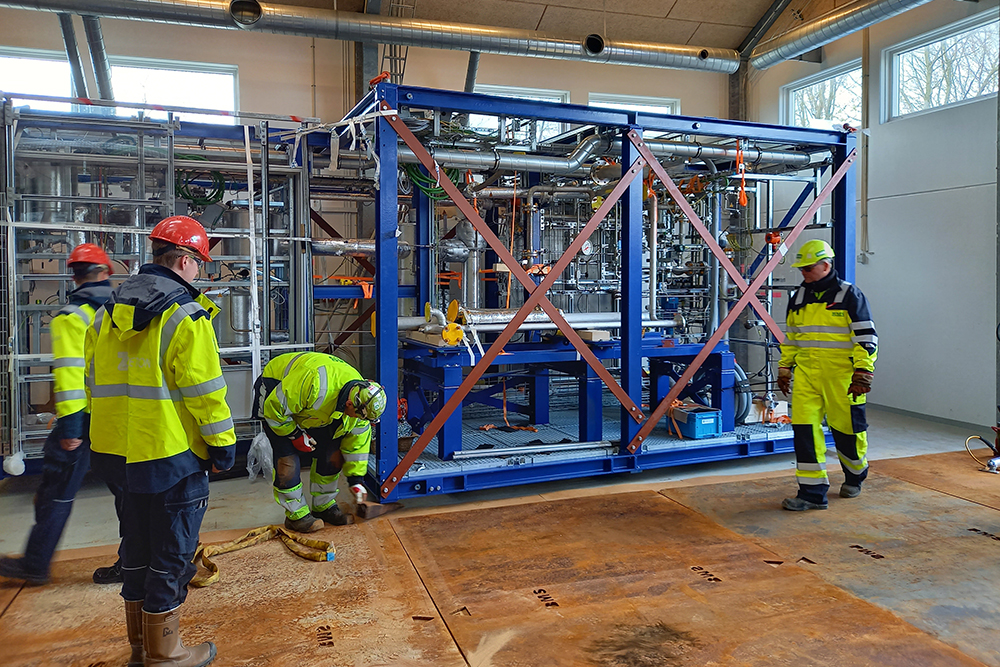
Each year, around 110 million tonnes of methanol are produced. Production is based almost exclusively on fossil fuels and therefore it emits significant quantities of CO2 – for each tonne of methanol produced, approx. 1.4 tonnes of CO2 are emitted.
Now, in collaboration with Haldor Topsøe, the Technical University of Denmark, Aalborg University and others, researchers from the Department of Chemical Engineering and Biotechnology have set-up a new demonstration plant with potential to turn classical methanol production completely on its head.
The new plant can produce methanol exclusively from biogas and renewable energy. The project is funded with DKK 38 million from the Energy Technology Development and Demonstration Program (EUDP).
“We’re delighted with the results of the project so far. The system demonstrates a new electrical methane reforming technology (eSMR) that is crucial in a future based on renewable energy and the circular bioeconomy,” says Thomas Lundgaard, the project manager at the Department of Chemical Engineering and Biotechnology at Aarhus University.
He continues:
“The demo plant fits perfectly into our energy research plant at Foulum, and we’re looking forward to pursue the potential for further development and integrating the technology into the energy system of the future.”
Kim Grøn Knudsen, Chief Strategy and Innovation Officer at Haldor Topsøe, says about the project:
“With this initiative, we will demonstrate that we are able to transform classical production process into a fully carbon-neutral scheme. Specifically, we will demonstrate that sustainable methanol can be produced from biogas at a very competitive cost compared to other green methanol produced from non-fossil fuels.”
Methanol is an organic compound classified as an alcohol, and it is used for a wide variety of purposes. Among other things as a fuel and solvent, and as an extremely important platform chemical in the production of a wide range of other chemicals.
Currently, the liquid is usually synthesized from fossil natural gas. Methane is split into hydrogen and carbon monoxide by adding a quantity of the gas as energy input. The whole process is dependent on fossil fuels and energy sources, and this is where the new plant will change things dramatically.
The eSMR technology splits biogas using an electrically driven catalyst and with an energy supplement from hydrogen produced using electrolysis technology. By using renewable energy from wind and the sun, as well as biogas extracted from slurry and sewage sludge, for example, the technology can transform biogas into methanol through a completely sustainable process.
The project is being managed by Haldor Topsøe, and the project partners are Sintex A/S, Blue World Technologies, the Technical University of Denmark, Energinet A/S, Aalborg University, PlanEnergi and the Department of Chemical Engineering and Biotechnology at Aarhus University.
The plant has an annual capacity of 100,000 litres of carbon-neutral methanol from biogas and green power, and it is planned to be fully operational in early 2022.
In a world powered by green energy sources, there’s an essential need to store energy for periods without sun and wind. There is also a need for fuels and chemicals for the parts of industry and infrastructure where fossil resources cannot immediately be replaced by renewable electricity.
This is where Power-to-X comes into play. Using excess electricity from renewable sources, the technology converts this power into carbon-neutral fuels or chemicals (i.e. methanol), which can readily and easily be stored and used the same way as fossil resources – for instance directly as drop-in fuels for ships, heavy traffic and aircraft or as platform chemicals in the chemical industry.
Power-to-X is a crucial element in the green transition and a vital piece in the concept of circular bioeconomy, where nothing goes to waste, where no fossil fuels are dug out of the ground, and where there is a sustainable alternative for everything, we dig up today.